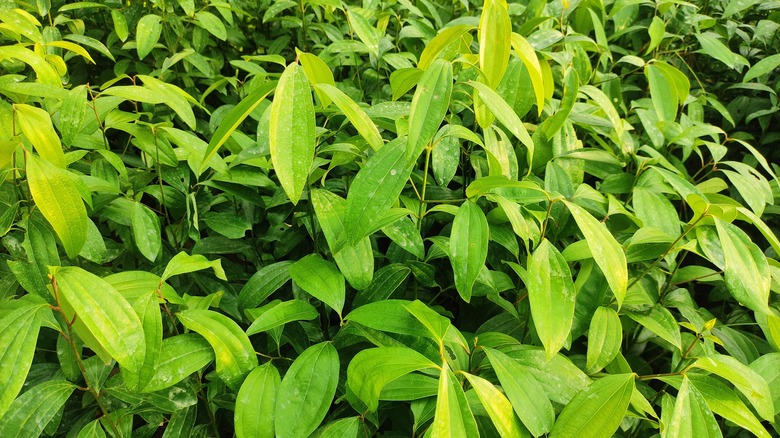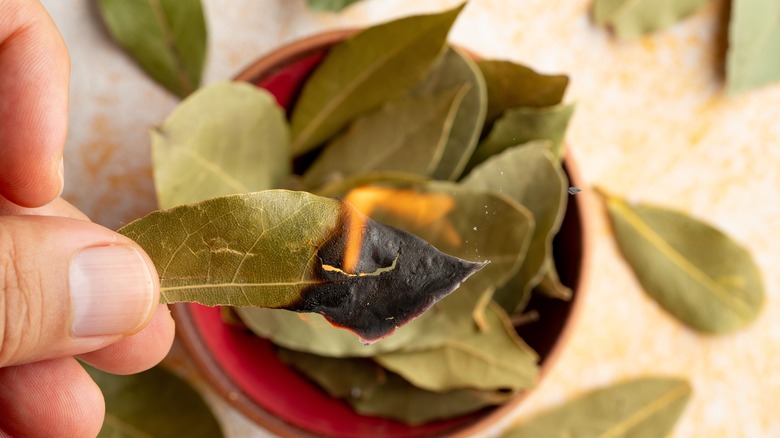This Is The Country That Exports The Most Bay Leaves
As a historic center of all things related to spice and flavor, it comes as no surprise that India is the world's leading exporter of bay leaves. With 1,464 producers exporting 37,332 shipments to 140 countries between March 2023 and February 2024 (per Volza), India dominates the international export of this uniquely flavored herb thanks to its climate, geography, and cultural affinity for the bay leaf. But despite being found in a cornucopia of dishes, from West African jollof rice to braised short ribs, bay leaf demand extends far beyond food.
International demand for the Indian-grown herb, whether the Indian bay leaf or West Indian bay leaf, comes from producers of not only spices and medicines, but also Bay Rum cologne and chefs looking to use bay leaves to keep bugs out of their pantries. Local demand for spices and medicine drives the bay leaf market in India, and local government policies enable large-scale community agriculture of the tree.
Not only is the Indian climate ideal for a tree originating in the Mediterranean, but the Indian government is also stepping in to encourage bay leaf cultivation as a means of injecting commerce into certain communities. For example, the bay leaf tree is well-suited to mountainous regions that may struggle to cultivate other crops, providing income, jobs, and, of course, spices to farmers.
Climate, geography, and culture for the bay leaf tree
There are several key reasons bay leaf trees are so widely cultivated in India, ranging from climate optimization to medicinal practices. These conditions create a unique synergy that makes India prime for bay leaf cultivation and export.
Bay leaf trees thrive in warm climates with plenty of rainfall, typically tropical and subtropical. The comparatively immense amount of rainfall in northern India, particularly along the Himalayan mountains, makes it a prime location for cultivating the tree. India also has long, hot summers and relatively short, mild winters, which pose a low risk of killing off bay leaf trees.
As a Mediterranean plant, bay leaf trees thrive in sandy soil. Though northeast India along the Himalayas is well-known for its bay leaf farmers, northwest India, in Bengal and along the coast, also sees its fair share of community cultivators. Coastal farmers often have sandy soil thanks to years of ocean erosion and shifting, creating a prime environment for mass farming of bay leaf trees.
Not only is the flavorful bay leaf found in many Indian dishes, it's also a vital component of many spiritual and Ayurvedic medicinal practices. Bay leaves are a medicinal and aromatic plant (MAP), meaning that they have recognized value as both a minor medicine and a food enhancer. Most often consumed as tea or in meals, locals believe bay leaf helps with a variety of minor ailments, ranging from hair restoration to minor respiratory issues.
Government and economic drivers of bay leaves
There is a distinct combination of factors, both economic and governmental, creating an increasingly favorable environment for bay leaf cultivators. As conditions for cultivators improve, this leads to a significantly increased supply of bay leaves for local and foreign trade.
In recent decades, the Indian government has strived to inject commerce from local and international markets into remote communities. Some local officials in tropical regions have shifted from offering bay leaf harvesting authorization from traders to producers, encouraging local populations to grow their investment and involvement in cultivating the tree. In 2003, one stretch of government-protected forest produced between 20 and 40 metric tons of bay leaf (per a 2011 report by ICIMOD).
With increased production came growing companies dominating the Indian export of bay leaves. Just three exporters control 59% of Indian bay leaf exports (per Volza). As these companies grow, so too does their influence over international spice markets and the popularity of India's unique bay leaves.
International demand for essential oil entices producers to set up distillation centers and trade relationships with bay leaf cultivators, supplying an additional channel for trade outside the culinary market. As the use of the entire tree becomes more internationally recognized, even instrument manufacturers are seeking out Indian bay leaf farmers. The lumber from a bay leaf tree, while not as easy to harvest and refine, receives much love for its unique sound.



